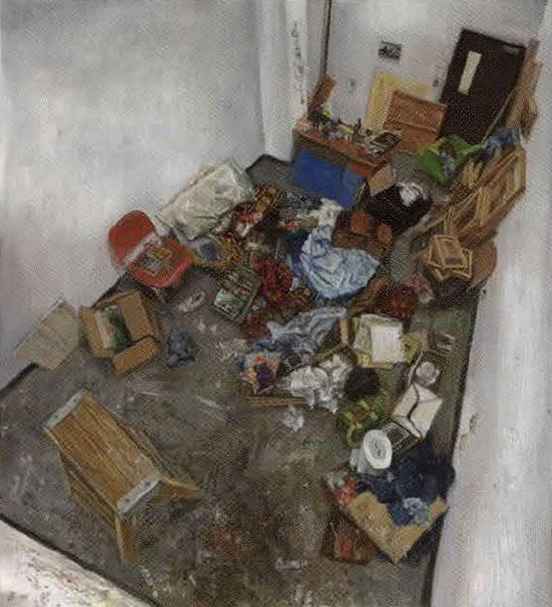By Michael Amy

Amer Kobaslija: Da Vinci Code, 2004, oil on panel,
12 ¾ by 11 ½ inches; at George Adams.
The Bosnian artist Amer Kobaslija approaches the venerable subject of the artist’s studio from unexpected angles. Using a creamy touch rooted in 19th-century realist painting, Kobaslija rendered bird’s-eye views of his windowless, now former studio at Montclair State University’s School of the Arts in New Jersey, from which he graduated in 2005. Intimately scaled oils on panel from 2004 and 2005 beautifully portray that private and idiosyncratic domain, where all is meant to facilitate the production of art. Feeling so cramped that he was occasionally compelled to climb a ladder for air, Kobaslija discovered from above the all-encompassing, vertiginous views that he photographed for use in his paintings.
In one work, the studio floor appears tilted, rising diagonally towards the right. The floor’s two nearest corners are cropped by the left and bottom edges of the painting, and all four walls are cut off, making them seem oblique. Kobaslija does not keep a tidy studio. Here, the floor is splattered (unsurprisingly) with paint; boxes, a chair, easels and bunched-up sheets of plastic and fabric take up much of the space. We notice the facilitating ladder in its entirety, steeply foreshortened at the bottom left. The picture’s title, Da Vinci Code, underscores a certain mystery.
The subject of the studio has autobiographical resonance. Am I reading too much into Kobaslija’s paintings when I suggest that, on one level, they may be interpreted as metaphors for the chaos that prevailed in Bosnia a decade ago, and from which the artist found refuge both in the studio and in art? The paint splatters. may allude to shed blood, the objects littering the floor to carnage and ruins, and the oblique angles to a world gone mad. In Painter’s Floor with an Open Door, the studio, bathed in a greenish-blue neon glow, has been stripped bare, except for a metal stool, a large broom and the ladder standing in the bottom right corner. This makes for a gloomier work, speaking of loss, loneliness and transition. Kobaslija obtains a wide range of optical and emotional effects through his skillful handling of oil, light and, in particular, space, which he contracts, expands, cantilevers and warps as if it were made of rubber.
